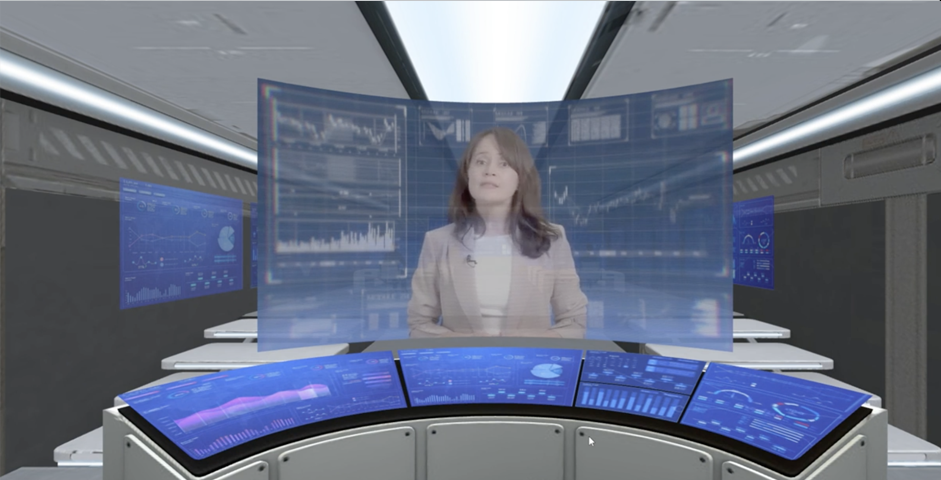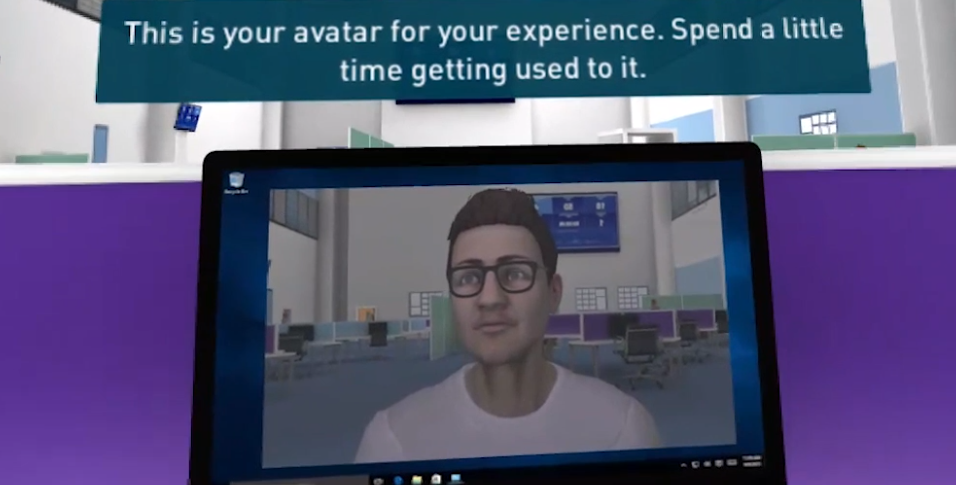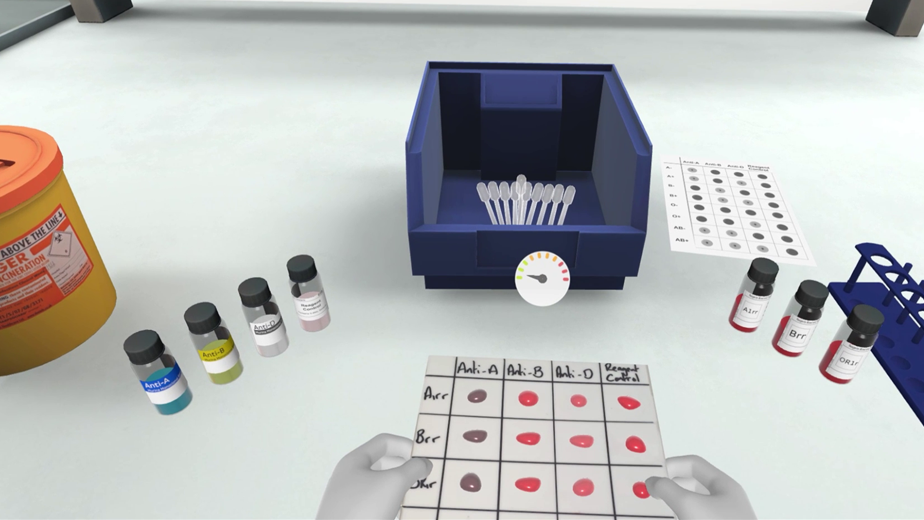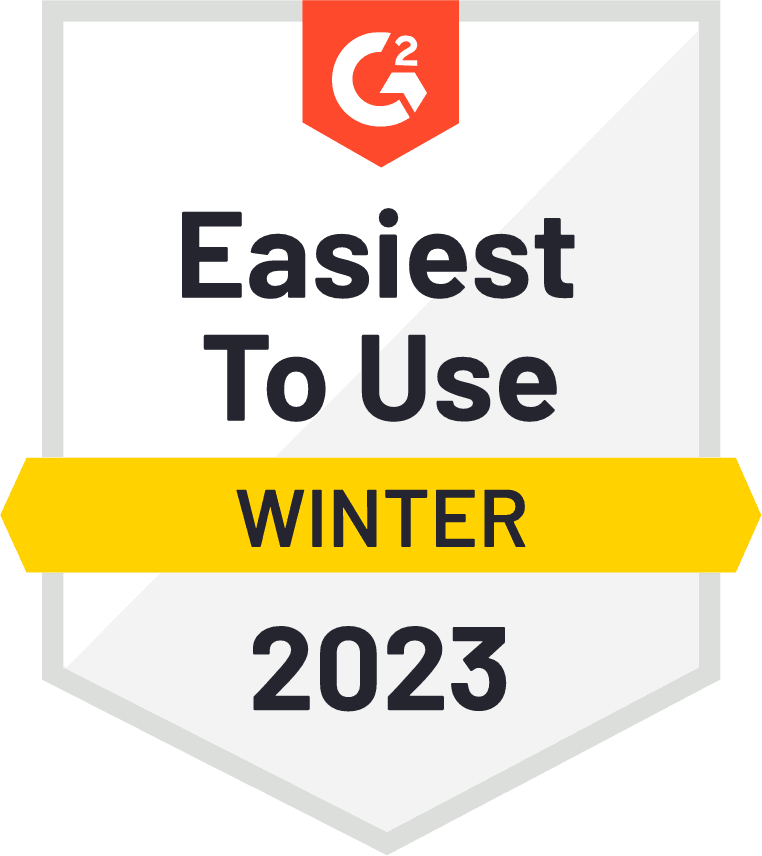Make Real
Make Real is an award-winning immersive technologies content developer, with a proven track record in creating validated, meaningful and memorable learning experiences for the enterprise and entertainment sectors, at work, in and out-of-home.
Our background in learning, games and simulation design and development means we lead the way in creating content determined by objectives and outcomes, not driven by the technologies. However our team of creatives, coders, designers – and our internal partnerships team – ensure we remain at the forefront of the technology and understanding audience and user needs, always looking to evangelise and educate partners on the benefits and use cases of immersive technologies.
We are trusted by some of the world’s largest organisations to design and deliver their learning & development, training and simulation solutions, including Vodafone, Lloyds Banking Group, Porsche, McDonald’s and EDF Energy.
Make Real is an approved developer partner with Oculus for Business ISV, HTC Vive, Microsoft HoloLens, Sony PlayStation VR and Google. We are also accredited enterprise learning provider partners with Learning & Performance Institute and The Institution of Engineering and Technology.
Notable Customers:
Media Gallery
Use Cases
Case Study #1: EDF Energy – Inclusive Leadership
Bringing diversity and inclusion to life
In late 2019, EDF’s Head of Diversity and Inclusion was looking for an innovative way to bring their Everyone’s Welcome vision to life and tackle a common issue that many organisations face with recruitment of people from ethnic minorities. They also received feedback in their annual employee engagement survey that their colleagues with disabilities, their LGBTQ+ people and those who are carers for others, didn’t feel as fully included or considered.
EDF designed and facilitated a workshop to explore the problems and assess what solutions it could offer. It wanted to learn from a diverse range of thoughts, opinions and roles and invited a broad range of employees, including members of its disability and carers network, other employee networks, individuals from all levels of the organisation, HR and Occupational Health.
During these discussions two prominent phrases were mentioned time and again:
- “For many it’s simply having the opportunity to experience a day in the life of.”
- “Embodying someone else and seeing what they have to deal with on a daily basis and the challenges they face, that lived experience (even for a few minutes) would be massive.”
This led to the idea of using technology to provide that embodiment experience for the user.
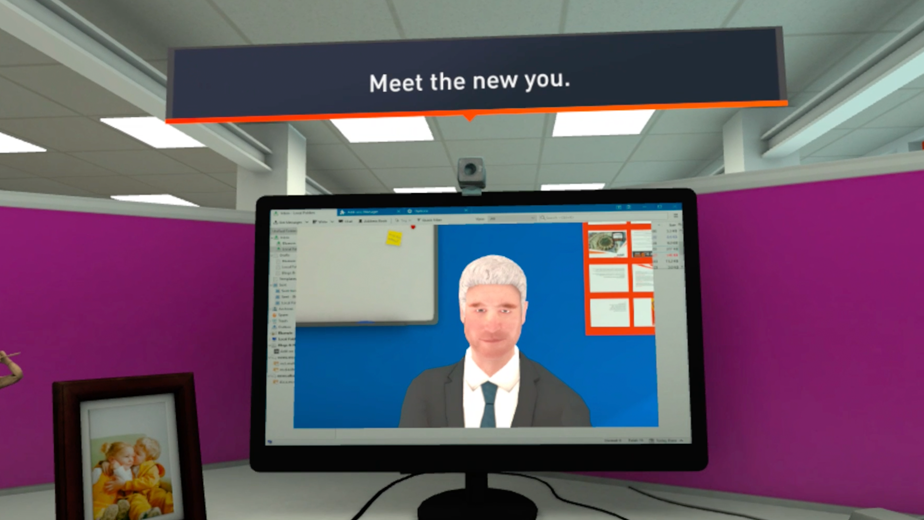
The Challenge:
As an organisation, EDF recognised that its recruitment of diverse individuals wasn’t where it wanted it to be.. So, it was key that this be a focus of the experience. EDF also wanted to incorporate the experiences of working parents within the workforce.
EDF wanted senior leaders to be the initial audience for this experience. It should:
- Help leaders develop empathy and understanding of the lived experience of others.
- Act as a conversation starter to share and discuss difficult issues that sat in EDF’s recruitment and hiring culture.
- Target improvements in the recruitment pipeline to help support EDF achieve its diversity and inclusion ambitions, so that its employees would fully reflect the diversity of the areas in which they operate.
- Help EDF on the journey to have a fully diverse senior leadership team.
EDF identified virtual reality as an ideal means of conveying this experience by transporting the learner into another person’s virtual body to get them to ’live’ that person’s experience. On investigating the technology, EDF found research showing that VR can create emotional connection for the user, and deliver much greater impact than e-learning, or face-to-face training.
Initially EDF turned to off-the-shelf Diversity and Inclusion VR content. While much of it was good, it didn’t cover its specific objectives or the uniqueness of the challenges it faced as an organisation.
The solution was to invite external companies with VR expertise to respond to a brief for developing a bespoke experience.
In October 2020, EDF invited us at Make Real to work on creating a VR proof of concept to show the power of VR in addressing issues of diversity and inclusion. The aim was to create the experience within six months to showcase to EDF’s Chief People Officer and her leadership team.
The COVID pandemic created further challenges, leading to all aspects of production taking place remotely. Despite the difficulties, EDF was keen to make sure that the solution wasn’t limited to just a small project group – rather, a wider group of multiple individuals would feed into the final release.
EDF’s project team and Make Real worked in collaboration with EDF’s employee network for Race and Cultural Equality (RACE) as well as HR business representatives from each operational business. The solution was driven by the power and raw honesty of those design sessions, in which people shared recent personal experiences.
One thing that these sessions highlighted is that overt racism and poor behaviour were easy to spot, but microaggressions, things that could be dismissed as banter, were the most endemic and painful experiences. These were ultimately what made people feel left out or unwelcome.
“Make Real really brought this (experience) to life through their design process and scripting.”
The Solution:
The experience was developed for the Meta (formerly Oculus) Quest and Quest 2 headsets.
It was important to EDF that the environment felt real and recognisable to the target audience, so we were careful to research and model office and break room environments that looked and felt like real EDF locations.
The experience is about how different two perspectives of the same conversation can be and how we all tend to make snap observations based on the often limited information that we have.
It uses embodiment to allow the learner to see events through the eyes of Tony, a senior leader who is transitioning to an independent consultant role after a rewarding career at EDF, and who is clearly representative of the majority demographic within EDF at the time.
The experience begins with the learner looking at their laptop with a view of Tony captured by a webcam. The learner is told they are going to see things from Tony’s perspective and has an opportunity to see how they are controlling Tony with their hand and head movements. This then leads into Tony having a conversation with two people he’s considering to take over his role.
One is Martin, 35, who is very similar to Tony, working his way up from his first job in EDF as a school leaver. He shares Tony’s strong work ethic and prides himself on building an extensive network, both in the workplace and at staff socials.
The other is Rashid, 28, who joined EDF on a fast-track graduate scheme. Because his daughter has health issues and requires extra care, Rashid is careful to balance his work and home life. He works a four day week and rarely takes part in work socials, as these often revolve around alcohol and late nights.
The conversation takes place in the break room, and sees the three characters discussing Tony’s forthcoming departure and who will be his replacement. The learner can make choices at key points to steer the conversation. Afterwards, the learner has to choose words they most associate with Martin and Rashid, showing the quick judgements made in the conversation.
The learner now experiences a perspective switch, repeating the embodiment exercise, but this time through Rashid’s eyes. They then relive the entire conversation from Rashid’s point of view and hearing Rashid’s thoughts as the chat progresses. In this part of the conversation, the learner can start to see how Rashid is isolated by the prevalent work culture and how seemingly innocent ‘banter’ can add to that feeling of isolation.
After this second viewing of the conversation, the learner completes the word association exercise again. This is important for challenging learners on their own snap judgements, unconscious bias around perceived behaviours, and assumptions they make about people.
Finally the learner is asked to commit to a pledge of two different actions they will commit to following to improve their support for diversity and inclusion at EDF.
EDF has doubled the recruitment of ethnic minority people, halved the attrition rate and significantly increased the number of ethnic minority employees.
Results:
The experience was positively received by EDF, who said “Make Real really brought this (experience) to life through their design process and scripting.”
Initial testing of the solution with a focus group (the Chief People Officer and HR directors from across the business) presented its own challenges because of the COVID lockdown. Equipment was sent out to each participant with instructional videos to help them set up and use the experience. An engaging feedback chatbot elicited feedback. The responses were overwhelmingly positive (see sidebar Feedback from Focus Group)
In January 2022, EDF completed a soft launch with 20 VR headsets and took the experience to different teams across the business to showcase both the Diversity and Inclusion experience and the VR technology. Of the 315 individuals trying the experience, 177 left feedback, which was again, overwhelmingly positive (see sidebar Feedback from Soft Launch).
This first experience with VR has ignited a lot of interest across the business:
- The Sales and Marketing team is looking to explore the use of VR to demonstrate what SMART homes could look like in the future.
- The Health, Safety & Environment teams across the business are exploring VR as a means of building an immersive emotionally connected experience.
- The property services team is exploring what VR could look like for site induction and orientation.
- The HR team is looking at what VR can do in supporting its onboarding process for new inductees.
EDF has reported that the investment in this proof of concept has represented a clear and positive saving over the costs of their existing leadership courses that discuss and build self-awareness around the topic of Diversity and Inclusion.
The experience has contributed to some key achievements:
- EDF has managed to double the recruitment of ethnic minority people, halve the attrition rate and significantly increase the number of ethnic minority employees over a 12 month period.
- It has also introduced a new company dashboard metric as part of their company incentive scheme where they are aiming for 50% of their senior leaders to have one or more diverse characteristics by 2030. (As of June 2022 they were at 27%).
The Experience:
Watch highlights from the experience:
The Make Real Perspective:
EDF’s conversations across the business about this experience helped it have much-needed discussions about Race and Minority Ethnicity representation and recruitment, and what it feels like to have flexible working needs as a carer. These conversation were initiated not just from experiencing the finished product, but also from its concept, discussing the need for it, through its design and development phase, right through to the soft launch and people experiencing it.
Those who have experienced it have a greater understanding of what it’s like to not feel welcome within the organisation.
Make Real is proud to have been able to contribute to this cultural shift within EDF. It’s important to us that every partnership with organisations like EDF is a learning experience for both Make Real and our partners.
For example, one important aspect of soft skills VR experiences like this is the character animation. Realistic and believable character animation makes the experience more immersive and provides the best opportunity for learners to focus on the learning objectives without distractions.
At Make Real, we’re committed to a process of continual improvement of our animation process and techniques. The lessons learned from this project formed an important input into that cycle of continuous improvement.
We have gone on to implement other highly successful soft skills solutions that build on the success of this one.

Case Study #2: Lloyds Banking Group – Data City
The Challenge:
Data analytics make the world go round. With 2.5 quintillion bytes of data created every day, there’s an abundance of information to be mined and valuable insights to be discovered – if only we knew how to tap into it.
In 2021, a report by the UK government found that half of businesses struggle to recruit for roles requiring data analytic skills. Upskilling workers to improve data literacy is increasingly becoming a priority for executive leaders.
And it’s not just analysis where there are knowledge gaps about data. Anyone across an organisation who might from time to time need to touch, change and transform data – which is basically everyone in an organisation – benefits from having a better understanding of data and its usage, capture, storage and control.
In this project, Lloyds asked us to help create a solution to drive engagement through a digital learning experience to make content about data relatable and fun, and to look at the subject beyond pie charts and number crunching into something with practical usefulness for a broad audience.
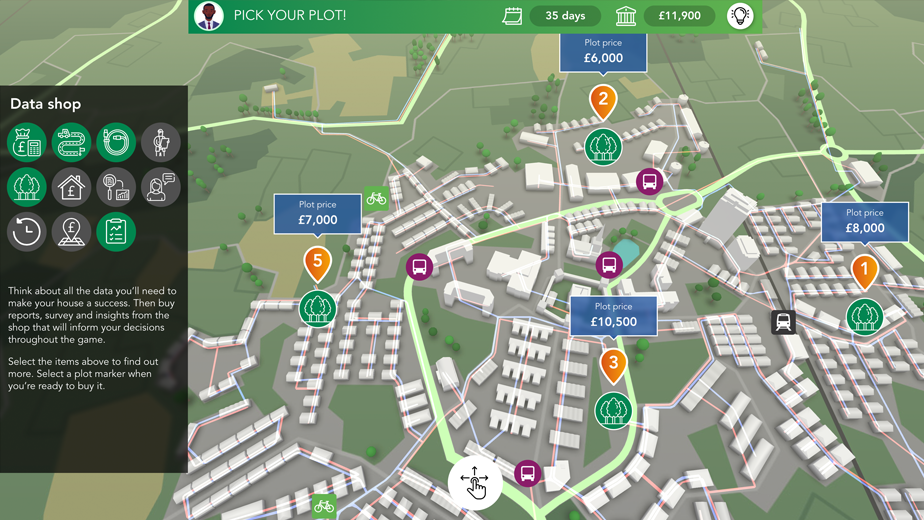
Our Solution:
Here’s a little known secret for you. Exploring data, when contextualised through a tangible real-world scenario, can be exceptionally enjoyable.
No, really.
For this project, we created a serious game which gave learners a single clear objective: build a house within a fictional city.
Learners can choose from a range of characters to play with, from the profit-motivated property tycoon through to a social-conscious environmental campaigner. With the character’s goals to keep in mind, learners then set out with a fixed budget and time scale to build the best house possible for the specifications they need to work to.
But, along the way there are plenty of opportunities for the project to be thwarted. Not using data or using the wrong data can lead to you falling foul of building regulations, running out of cash, incurring fines or missing critical deadlines.
There is help on hand, however. Feedback at the end of each round tells you not only how well you’re applying data to make each decision, but whether you’ve even using the right data in the first place.
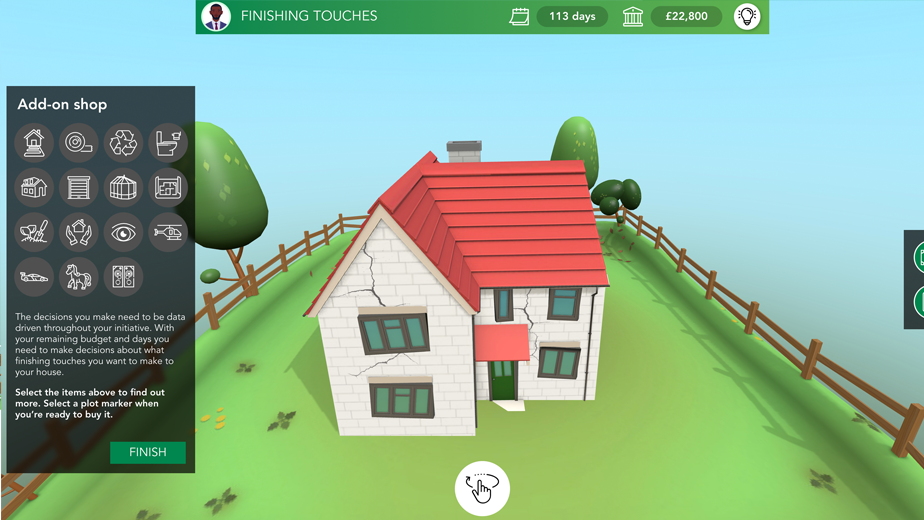
Good Game, Good Game
Done well, serious games (or, to be more precise, “games that have a primary purpose other than merely to entertain us”) can be an excellent way to engage and motivate learners.
By setting learners a simple goal – to build a house – we give learners a clear instruction that doesn’t exhaust their cognitive power trying to digest complicated rules. Learners are left instead to push beyond their existing knowledge and skills, gathering what they need throughout the course of the game in order to achieve the desired end result.
But, just like in the real world, charting a path through the abundance of information is easier said than done. This brings a genuinely meaty challenge to the game. The greater number of pitfalls increases the chance of error; there’s next to no chance that learners can coast through the game with fluke and guess work. To succeed in Data City, you have to be engaged. Even then, if you get to the end and find the house you’ve built contains cracks, or there’s a toxic leak under the foundations, you can’t help but want to go back to start and have another go.
By laying bare the complexity of the subject matter, the game shows how data underpins everyday life in substantial ways. Even for the maths-averse like me, seeing the application of data in a real-world task opens up insight into how data can help us do things much better.
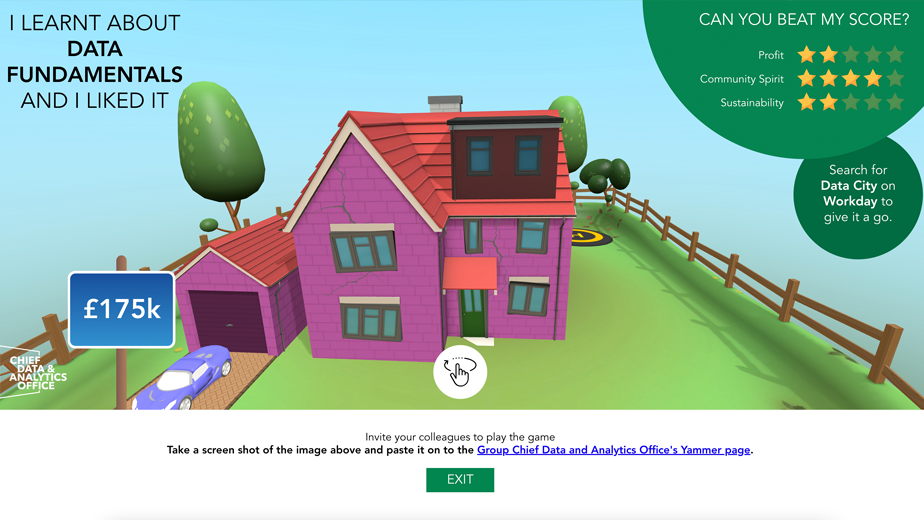
Case Study 3: NHS – Tile Blood Grouping VR
The Challenge:
Blood type identification is a simple and common process, but the effects of getting it wrong can be devastating. Even a small amount of transfused blood of the wrong type can very quickly cause serious illness & even death.
Use Case:
The primary purpose of this experience, as outlined by the requirement of the NHS Blood & Transplant department, is to show how quickly blood agglutination can occur when different blood types are mixed. The aim is to build understanding around how important it is to select the right blood type for transfusions and what can quickly go wrong for the patient if you don’t.
To deliver on that purpose, by the end of this experience learners are able to:
Replicate the tile method for identifying blood types.
Deduce a blood type from Red Blood Cells (RBC) agglutination evidence.
List laboratory best practices: correctly setting up controls, demonstrating dexterity with fine motor skills, and being methodical in their approach.
Discuss the importance of selecting the right blood type for transfusions.
Explain the consequences of giving a patient the wrong blood type.
Learn without using vital blood supplies and/or generate additional hygiene and plastic waste (pastettes & pipettes).
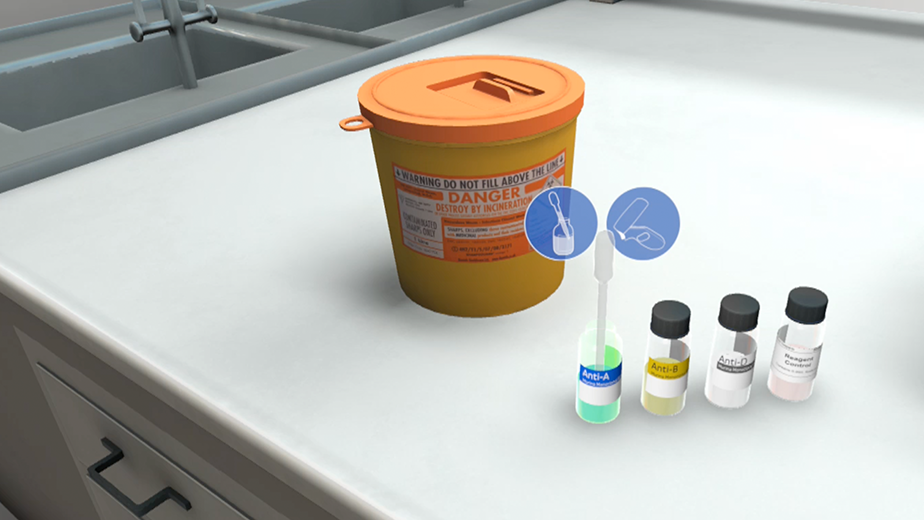
Build:
As a pilot stage concept, Make Real and NHSBT worked together closely to ensure maximum value for the limited budget was achievable for development into this important area of training and end use case. Only by developing for Oculus Quest full VR hardware, offering reliable 6DoF tracking, performance and contained standalone nature could VR be deployed within hospital training environments, free from tethers and other hardware requirements, otherwise increasing costs and health & safety risks.
The finesse of the Oculus Touch controllers and their input meant that the delicate, fine motor skills necessary to interact with a pipette and the motion of mixing the blood to enable agglutination to occur, without causing contamination between samples upon the grid, combined with virtual feedback systems to inform the learner of their method suitability and necessary pressure levels.
Despite being a pilot, the design has incorporated a deep matrix of possible variations of patient and blood type, ensuring that the training is more than just learn by doing, but relies upon the learner to apply their knowledge and understanding with each play-through in order to correctly determine blood types as a result of the simulation of agglutination and choosing the correct blood type for transfusion and saving a virtual patient’s life.
This project will be the first to be rolled out across NHS using the new Oculus for Business enterprise platform for improved security of data, device management and enterprise features including kiosk mode and offline data collection and reporting, as a result of Make Real’s inclusion within the Oculus ISV Partnership programme.
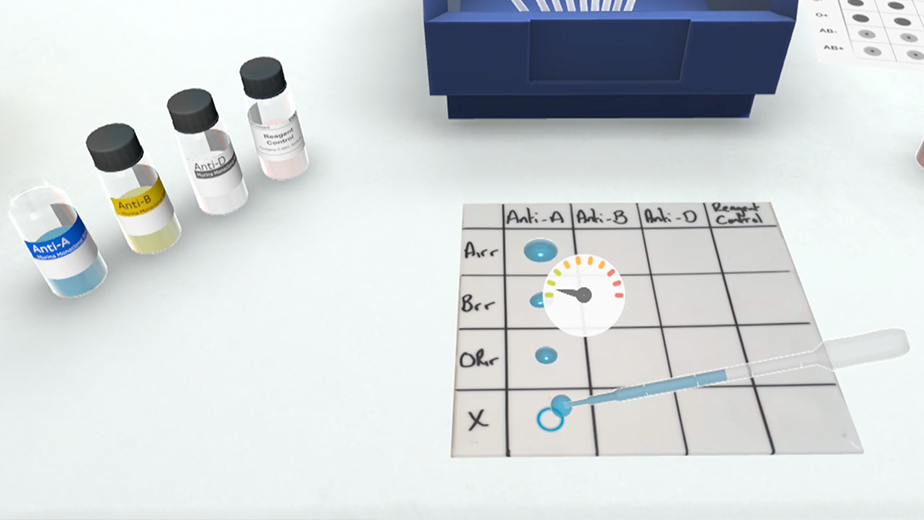
Impact:
Initial feedback has been overwhelmingly positive but due to deployment date and impact of coronavirus COVID-19 upon the NHS and wider health sectors, full-scale rollout deployment and testing has been put on hold temporarily as associated stakeholders have been positioned within the emergency response teams. However it has already opened up avenues of discussion around other use cases to apply VR training to, within NHS L&D and the wider organisation, beyond the stereotypical expected uses.
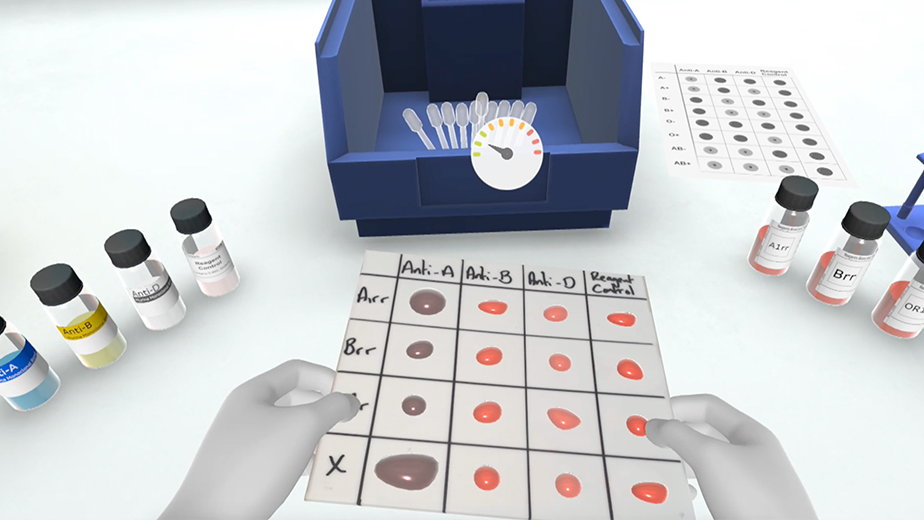
Testimonials
“Make Real really brought this (experience) to life through their design process and scripting.”
– EDF Energy
“VR has brought massive benefits to learning at St James’s Place and has enabled us to enhance our existing content too.”
– St James’s Place
Additional Details
ArborXR Demo Available: No
Trial Period Offered: No
Regions Supported: North America, South America, APAC, EMEA, LATAM
Notable Milestones / Awards:
- Learning Technologies Awards – Excellence in the design of learning content – Make Real Ltd & Lloyds Banking Group – ‘Hear to Listen’ (gold)
- Learning Technologies Awards – Best use of simulations or virtual environments for learning – Make Real Ltd & EDF – ‘Diversity & Inclusion’ (silver)
- The Learning Awards – Learning Technologies Award (2022) – Make Real Ltd & Keltbray Group – ‘Skill Shield’ (bronze)
- Learning Technologies Awards – Best Use of Mobile Learning – Make Real Ltd & Vodafone – ‘Drive Safe’ (bronze)
- Learning Technologies Awards – Best Use of Virtual Environments & Simulations (2020) – Network Rail ‘COSS’ (designed and developed by Make Real Ltd & Brightwave)
- Learning Technologies Awards – Best Use of Virtual Environments & Simulations (2020) – Network Rail ‘COSS’ (designed and developed by Make Real Ltd & Brightwave)
- Learning Technologies Awards – Most Innovative New Learning Technologies Product UK (2019) – Make Real ltd & EDF Energy – ‘Sentinel’ (silver)

Type of Developer: AR, VR
Type of Content: Custom, Off-the-Shelf
Device Support: HTC, Oculus / Meta, PICO, Lenovo, Magic Leap
Industries: AEC, Automotive, Energy / Oil & Gas, Healthcare / Medical, Safety, Soft Skills
Established: 2001
Headquarters: United Kingdom
Access All Demos Now
Access demo apps from top enterprise and education developers for free.
